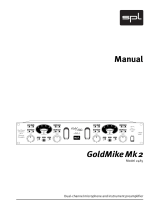
MM-1 User Guide and Technical Information
3
Specications
Gain: (Mic to Line) 0 dB to 66 dB input to output, switch selectable
Gain Accuracy (Mic - Line) +0.6, –0.1 dB with reference to front panel gain markings
(150 ohm source, 100k ohm load impedances)
Frequency Response
(Mic - Line)
20 Hz –20 kHz, +0.1, -0.5 dB, –1 dB at 50 kHz (relative to 1 kHz level with 150 ohm source)
MM-1 Frequency
Response
-- w/80 Hz HP
·· w/160 Hz HP
-6
+1
-5
-4
-3
-2
-1
+0
d
B
u
10 100k20 50 100 200 500 1k 2k 5k 10k 20k 50k
Hz
Equivalent Input Noise: (Mic) –126 dBu (–128 dBV) maximum
(150 ohm source, flat weighting, 22 Hz – 22 kHz bandwidth gain setting 36 dB or greater)
Output Clipping Level: (Line) +22 dBu minimum with 100k ohm load
+20 dBu minimum with 600 ohm load
Input Clipping Level: (Mic) +4 dBu minimum at the 0 or +18 dB gain setting
Dynamic Range: (Mic to Line) 122 dB minimum at the +18 dB gain setting
THD + Noise: .05% maximum (from 50 Hz – 22 kHz @ +4 dBu output level, 22 Hz – 22 kHz filter bandwidth,
+46 dB gain setting
Common Mode Rejection Ratio: 100 dB minimum at 80 Hz
60 dB minimum at 10 kHz
Input (Mic): Transformer-balanced, 2k ohm input impedance
Input: (Monitor) Electronically-balanced, 22k ohm input impedance
Output: (Line) Transformer-balanced, 130 ohm output impedance
Headphone Output Impedance: Unbalanced, 200 ohms
Frequency Response: (Monitor In) 10 Hz – 50 kHz, ±0.5 dB, gain at 50 %
Frequency Response (headphones): 10 Hz – 50 kHz, ±0.5 dB, gain at 50%
Input Clipping Level: (Monitor In) Greater than +30 dBu
High-Pass Filter: 80 Hz or 160 Hz (switch selectable), 6 dB per octave
Phantom Power: 12 V or 48 V (switch selectable), will supply 10 mA per DIN 45 596 specification
T-Power: 12 V via 180 ohm resistors, will supply 10 mA
Limiter: Limits to +17 dBu output level, 10:1 limiting ratio
5 ms attack time, 100 ms release time
Amber/Red LED indicates limiting/clipping
Internal Voltage Rails: ±15 V, regulated
Power: Internal: 2 x AA batteries
External: 5–17 VDC via threaded coaxial jack, (5.5 mm outer diameter, 2.1 mm inner diameter),
pin positive, sleeve negative.
Voltages above 17 VDC cause no damage to unit but will open an internal poly fuse. Poly fuse will
reset when voltage is removed.
Polarity: All inputs to all outputs are non-inverting
XLR – pin-2 = hot, pin-3 = cold, pin-1 is ground
TRS – Tip = hot, ring = cold, sleeve = ground
Weight: (unit only) 0.64 kg, 1.42 lbs.
Dimensions: (unit only) 49 mm x 95 mm x 166 mm (h x w x d)
(1.95” x 3.75” x 6.55”)
Included Accessories: Mating DC coaxial power connector, 4 rubber feet















